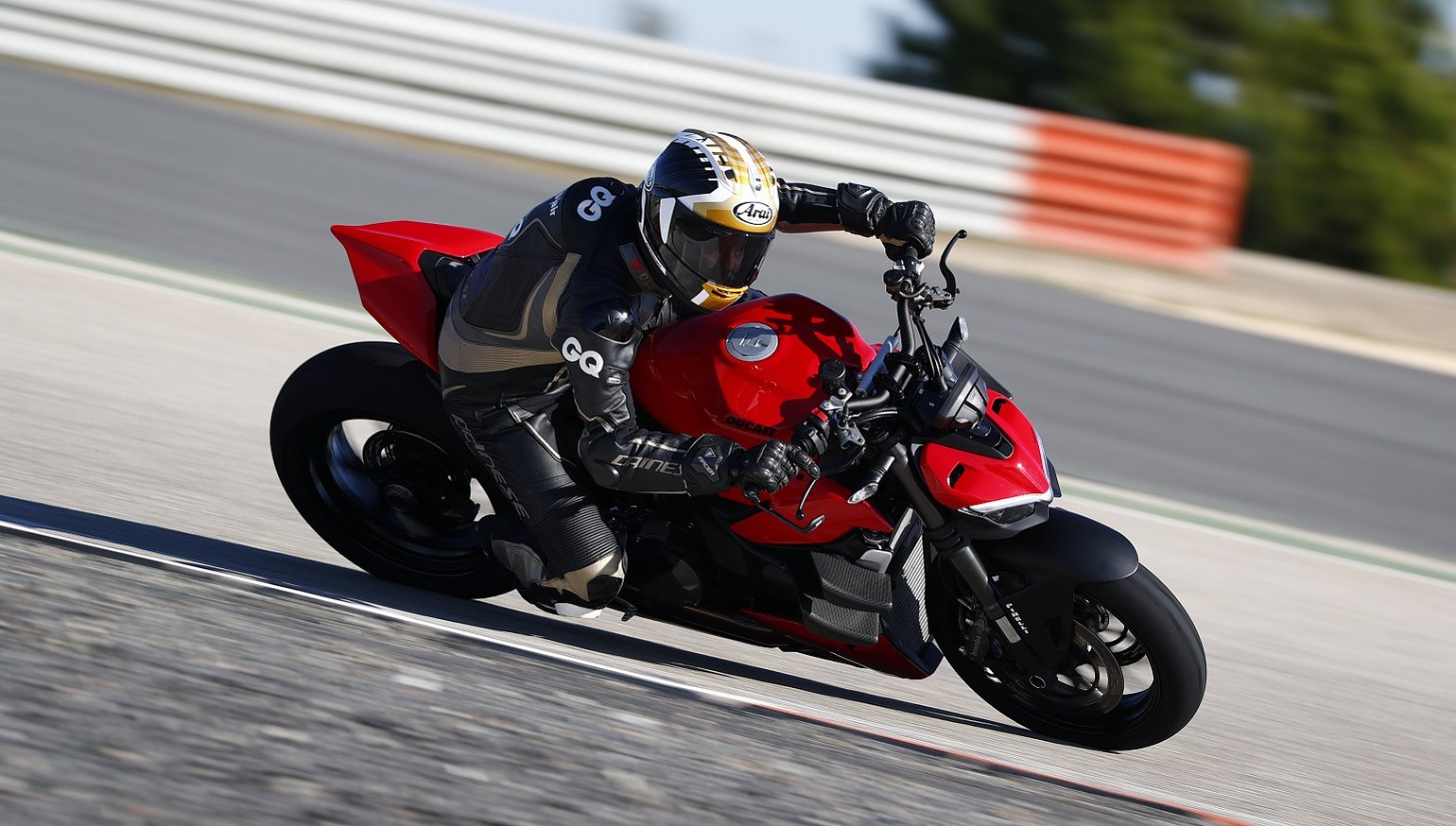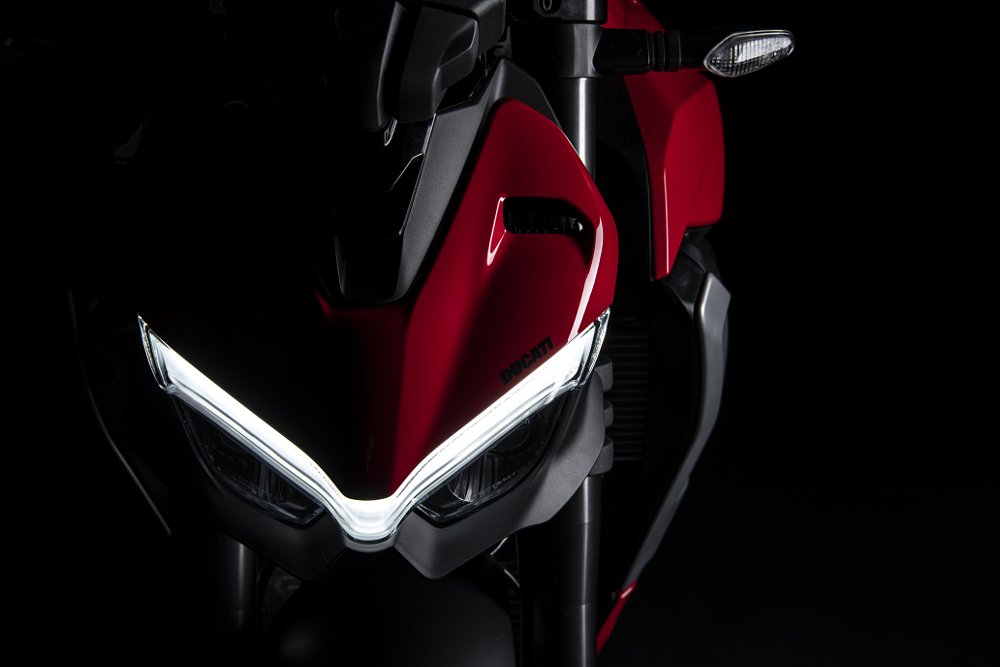There were many things we didn't know in 2019, and setting aside the obvious, least of all was that it would turn out to be a two-year wait after the announcement and subsequent launch of Ducati's Panigale V2 before we'd see a naked version with a handlebar. Now, finally, the wait's over. Enter the Streetfighter V2.
Ducati boasts that after a "reinterpretation of its fight formula" there's "a new fighter in town," and while that's good news, it still probably left some questions in your mind. Who's it aimed at? What changes were made? What's the perceived gap up to the Streetfighter V4? What does Ducati think the competitors are?
Ducati's Panigale V2 — the bike the Streetfighter V2 is based on — is a well-judged bike by any reasonable measure. In a world where manufacturers relentlessly chase ever bigger numbers and one-upmanship, Ducati mustered the courage to resist temptation and delivered 155 horsepower wrapped in a package that mere mortals could jump on and have a really genuinely good time. From that point on, it felt like a sure bet that keeping the recipe mostly the same, ripping the fairing off and replacing the clip-ons with a handlebar still ought to deliver 90 percent of the fun on track, yet be appreciably better in all the ways you'd want it to be on the street: comfier and easier to live with.
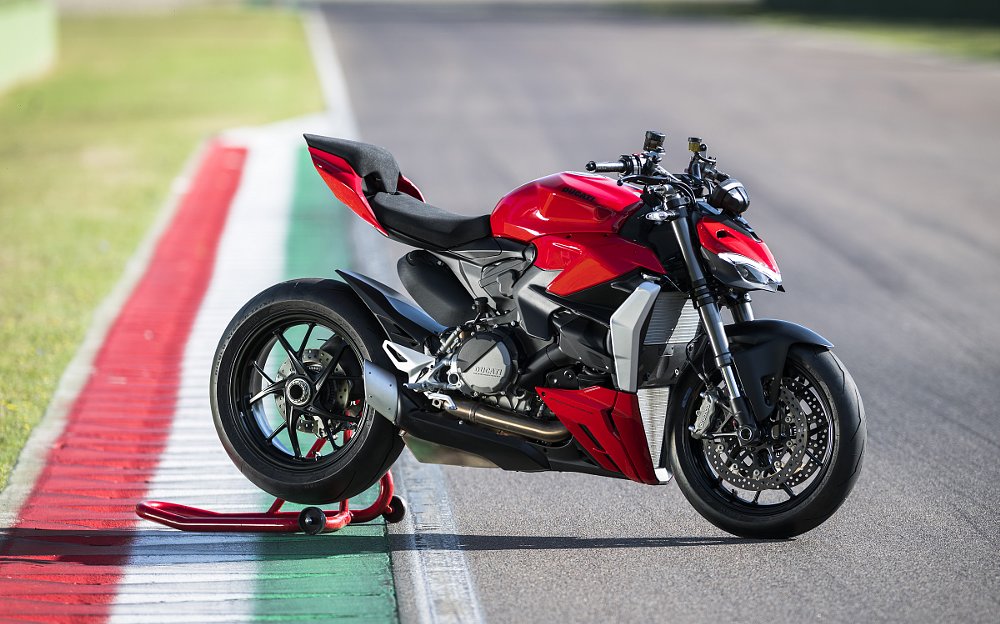
After the Streetfighter V2's announcement at Ducati's World Premiere series a couple of weeks ago, it looked like our wishes had mostly been answered. Seemingly using a pragmatic mindset of "don't fix what isn't broken," the Streetfighter V2's recipe is reassuringly close to the Panigale V2's. Ducati's official test rider, Alessandro Valia, said the aim was to create a bike that was involving on track and a head-turner in the city. He went on to explain that the brief also specified creating a tangible gap between the V2 and V4 models, while also achieving an instantly recognizable "family feeling."
The way the gap's created between the respective models is both visual and mechanical. The Streetfighter V2 is slimmer than its V4 counterpart, sports less of a chest, reduces the length of the "blade" running over each side of the radiator, covers up a lot more of the engine with black plastic and doesn't come with wings as standard (they're an optional accessory — $350 for plastic, or $1,435 for carbon). Weight remains virtually the same between the V2 and V4 models with the V2 at 441 pounds ready to ride. From a distance, thanks mostly to the signature headlight design, single-sided swingarm and pointy rear end, it's definitely a Ducati Streetfighter, and up close it's nowhere near as intimidating or imposing as its MotoGP-derived bigger sister. I make that two items successfully ticked off the list, then.
Mechanically speaking, the Streetfighter V2 is essentially identical to the Panigale V2, except the easily and most commonly configurable parts take on a more road-oriented outlook. Ducati says the front brake pad compound is less aggressive and the fully adjustable Showa fork and Sachs shock have a softer damping setup, both in an effort to lean more towards road use while still remaining handy on track. The wheelbase has grown by 29 mm from 1,436 mm (56.5 inches) to 1,465 mm (57.7 inches), and 16 mm of that comes from a longer swingarm. This also puts more weight on front wheel. The rear sprocket has sprouted two extra teeth, going from 15/41 to 15/43. The wheelbase and final ratio change do two things: add stability and add liveliness throughout the rev range, respectively. Alessandro, who has signed off every production Ducati since 2007, noted the 1,465 mm wheelbase is exactly the same as used on Chaz Davies' World Superbike race-winning 1299 Panigale R.
Two horsepower and two foot-pounds of torque have been lost in the transition to the Streetfighter V2, making peak power 153 horsepower at 10,750 rpm and a peak torque of 74.8 foot-pounds at 9,000 rpm. The losses are due to the smaller air intake. The rest of the engine internals — except for the final drive ratio — are completely unchanged. Everything from the valve overlap duration, to the throttle bodies, gearbox ratios and anything else you might care to point a finger at are pure Panigale V2 items.
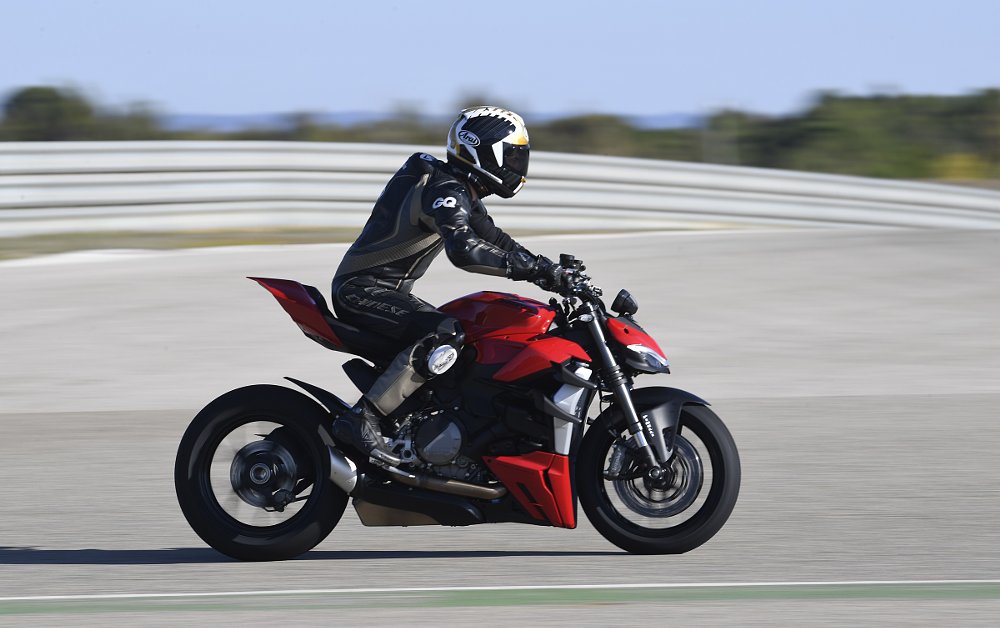
Ergonomically, the rider triangle has been rotated backwards and elongated between the seat and the pegs. Ducati also added a more padded seat for good measure, which adds width to the subframe but the stand-over width remains fairly narrow and therefore still relatively friendly if you're challenged in the leg department. The 4.3-inch TFT dash transfers directly over, as does the handlebar switchgear. The electronics suite trades a race throttle mode for a wet mode, but otherwise remains the same with Bosch's Evo cornering traction control and ABS systems. Notably, there's no fuel gauge, nor cruise control or heated grips, either, but there's still multi-level wheelie control, electronic braking control, a bi-directional quickshifter as standard as well as slide control, if you've got the skills to use it. Torque maps are dulled slightly in gears one through three, with four through six receiving the full amount. Phew.
Summing up so far, there's relatively little to turn a nose up at: As a concept, the Streetfighter V2 is quite easy to wrap your head around. Your mind has likely already turned to contemplate two things: the competition and who it's aimed at. As for competition, there isn't another current model that seems to get particularly close. With about 150 horsepower and a $16,995 price tag in the United States, it sits directly between middleweight naked bikes like Triumph's Street Triple, KTM's 890 Duke R and Yamaha's MT-09 SP, and the usual suspect supernakeds, such as Aprilia's Tuono V4 1100 and KTM's 1290 Super Duke R. Some of you might be thinking that BMW's S 1000 R or perhaps Yamaha's MT-10 get pretty close at least in terms of horsepower, but I think the V2 has a decent margin over the BMW on the track and the MT-10 comes nowhere near on a race course. To have created what looks like a peerless model feels a little bit like a stroke of genius on Ducati's part. Sure, near-as-damnit $17,000 is a lot of cash, but the specs are right up there to justify it, and so's the build quality.
Who's it aimed at? Again, using Alessandro as a source, it's aimed at road riders who don't want the all-out V4 model but want the option of turning up at the occasional track day. It's hard to argue with that.
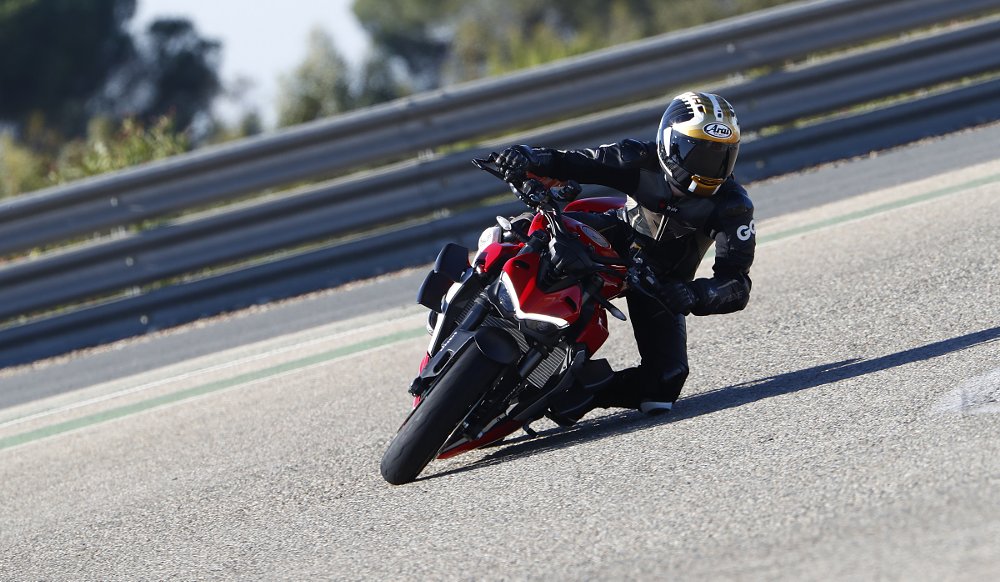
Riding the Streetfighter V2 on the track
Our day started at Circuito de Monteblanco, a bumpy and technical test track in the foothills west of Seville. Easing into the first session, the first thing that hits you is where the Superquadro makes its power. Below 9,000 rpm is fairly linear but once it hits that magic number, it absolutely rips to 11,000 rpm. It's almost two-stroke-like in its delivery, which keeps your foot busy on the gear shifter and makes gear selection paramount. It's fun and engaging, but in a lighthearted kind of way.
Second to hit home is just how good the feeling is at the front end, which is precisely what Alessandro identified as his favorite feature of the Streetfighter V2. Confidence equals speed, and with this amount of power combined with the elongated wheelbase, you're free to point it where you want to go, hang on to the brakes deep into corners, enjoy the stability, and then not have to manage it through or out of the corner because it doesn't have enough power to tie itself in knots in the first place. Funnily enough, that's precisely the characteristic the Panigale V2 is praised for, too. Speaking of brakes, you'd have to be a true superhero to arrive back in the pits wanting to swap out the pads for a more aggressive set: two-finger braking from an indicated 162 mph down to 40 for the turn-one hairpin was no problem at all from the 200-yard marker. The odd wobble from the front end shows up when you're giving big steering inputs, but that comes with big-naked territory, and it's amusing more than it is worrying.
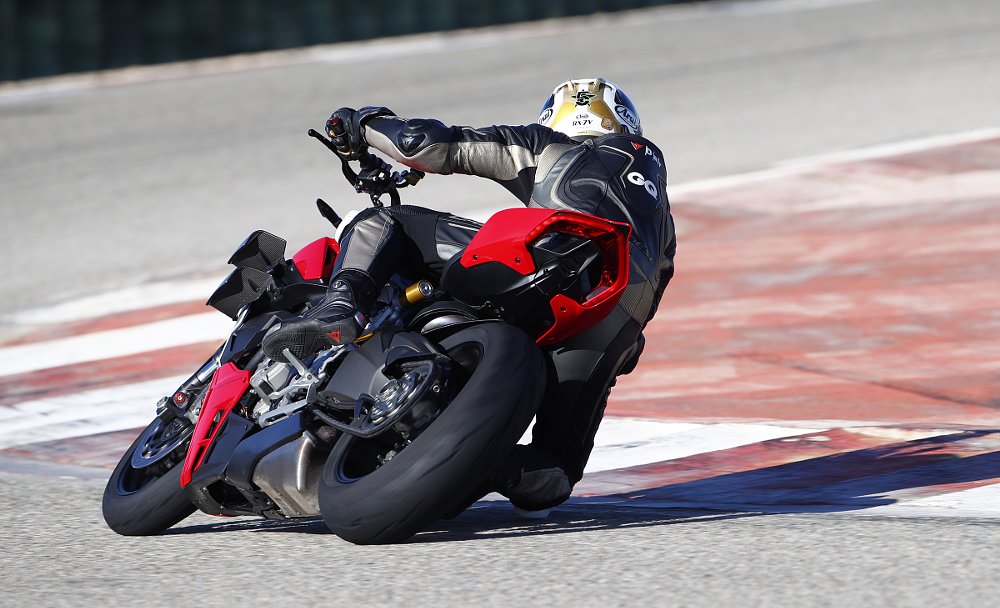
From the perspective of a frequent ride-to-the-track-and-ride-home-afterwards kind of track-dayer, it's hard to want for too much more. Loads of time is spent at full throttle and it all seems to fall on the side of wholesome fun and frolics rather than serious tenth-finding missions. There's a lap timer if you're so inclined, and hooking up Ducati's data logger is also possible. Stickier rubber would only make things even better, as the harder you push it the better it seems to get. On that note, Pirelli's Rosso IV tires do an alright job in this setting. They're happy to drop into corners at a moment's notice but you'll feel the electronics stepping in frequently, even when intervention settings are dialed back. ABS? Flawless and entirely nonintrusive, just as it should be.
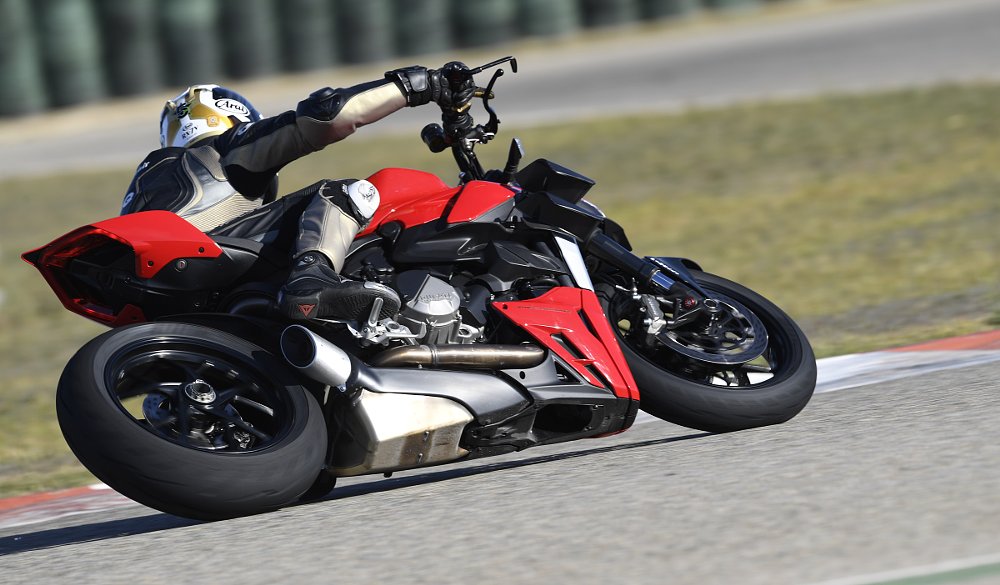
Riding the Streetfighter V2 on the road
Riding on the road is probably what you came here to read about, though, so here it is: Yeah, it's an enjoyable place to spend time. I tend to judge a bike in this setting primarily by how much I need to think about it, and the only brain space I was dedicating to managing the bike was at initial or low throttle openings at low speeds or around the hairpins in Spanish villages. Other than that, it's a breeze to ride around, wrapped up in an envelope of deep, bassy exhaust noise with the occasional pop and parp from the stubby side-exit exhaust.
Road mode (medium throttle response) is all I found I needed, as it offered the best throttle response for twisty roads. My admittedly race-weight 65 kilograms (143 pounds) and five-foot, nine-inch frame had zero problems with comfort on our 130-kilometer (80-mile) street ride and I personally would need to ride an awful lot further before comfort would ever be a problem to contend with. Your own mileage may vary, but I rather suspect most will have an easy time onboard, too.
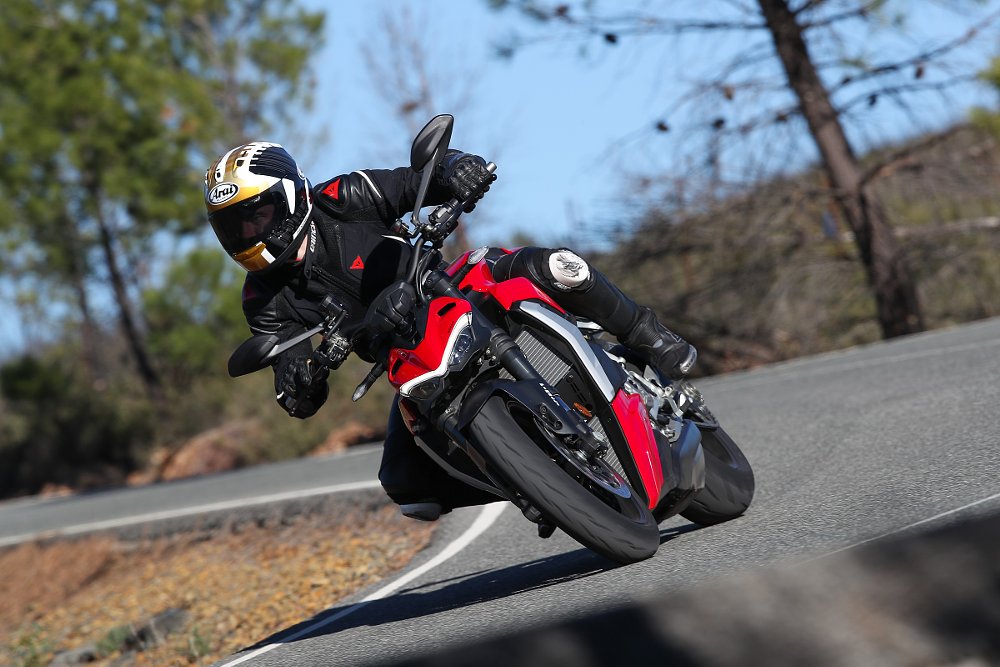
Coming from the track sessions prior, I was initially hanging onto revs much longer than I needed to and carrying an entire gear lower than necessary before I realized just what a difference the extra two teeth on the rear sprocket make if you give them a chance. Heading into a tight corner in third gear on a Panigale V2 is, to be blunt, a mistake, but the Streetfighter drags itself out without any complaints whatsoever. Ducati showed a graph (frustratingly with no Y axis, but an X axis showing kmh) of the torque difference in third gear across the entire rev range; from 65 kph (41 mph) all the way to 160 (100 mph) there's "more" torque, but how much is unknown. Just more. Either way, it makes a big difference.
Anyway, canyon carving is wonderfully taken care of, all but the heaviest town work is dispatched willingly. Steering lock would become an issue if you were really having to thread the needle, but it seems a hard thing to really moan about given what the Streetfighter V2 is. On our short street ride, the roads were so billiard-table perfect it was hard to get a feel for how the V2 would do on crappy surfaces. The takeaway points for me here are that, again, the front end is made of the stuff that takes you where you want to go simply by looking, and there being plenty of power but nowhere near too much. I was never left wanting. Again, you're made to feel like you're able to get the best out of it easily and frequently.
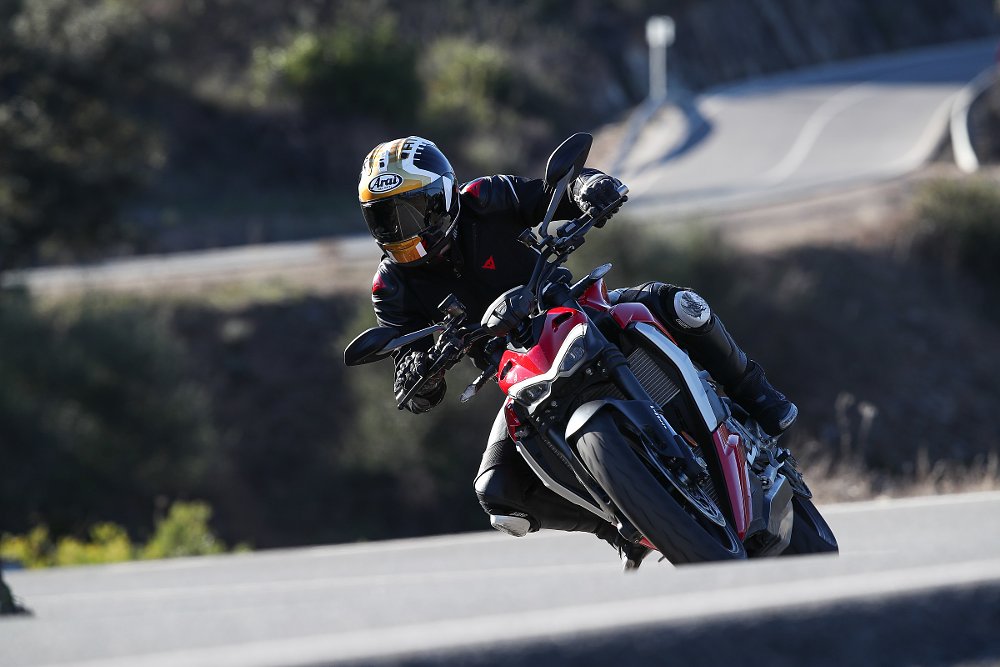
Final thoughts on the Streetfighter V2
As you've probably gathered, I'm a fan of this Streetfighter V2. I love how it looks, I like how it works on the road, and I'm taken with its ability to reduce you to giggles on track sorties. Let me give some extra context, though. I've done probably close to 5,000 road and track miles on the 955 cc Superquadro engine and know it intimately well. I've also spent considerable time on the Streetfighter V4 S and a Panigale V4 S claims a spot in my garage. What I found with the Streetfighter V4 was that, while it was a hair-raisingly brilliant piece of kit, I knew I was never getting the best out of it in any setting I piloted it. On the road I found it a constant tease; knowing the potency lurking within could never be put to full use. Similarly, on the track, it gets so frustratingly close to a Panigale V4 that it leaves you craving one of those instead for the riding position and fairing.
That's where the Streetfighter V2, for me, wins out, because of how accessible its performance is. You're much more able to tap into the engine on your favorite canyon roads — or even on your way to work — and it's not so savage on the track as to leave you feeling like you're getting 90 percent of the way there and then being denied the final percentage points. As the old saying goes, it's better to ride a slow bike fast than a fast bike slow. Not that the Streetfighter V2 is in any way slow — far, far from it — but you catch my drift.
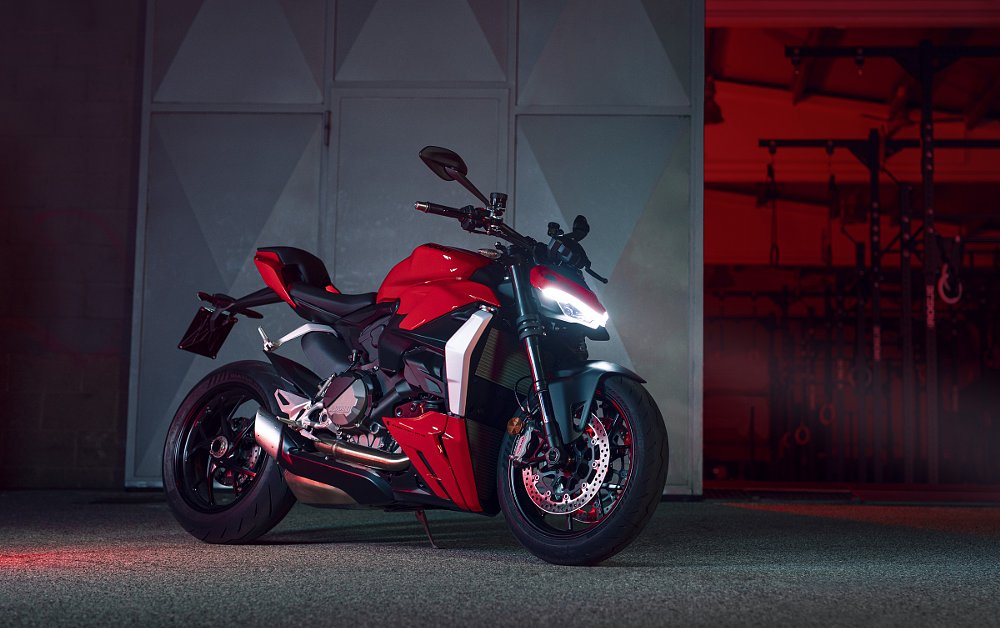
Absolutely there are some nit-picks. A $17,000 bike that's probably going to do more road than track miles probably ought to have even a token fuel gauge and cruise control. Heated grips would be the icing on the cake, and perhaps a bigger TFT too. That said, it's a lot of bike for the money, and I think it's one of those bikes that folks will line up to buy regardless of any shortcomings because it kind of is what it is: unapologetically a Panigale V2 with a handlebar.
| 2022 Ducati Streetfighter V2 | |
|---|---|
| Price (MSRP) | $16,995 |
| Engine | 955 cc, eight-valve desmodromic, liquid-cooled L-twin |
|
Transmission, final drive |
Six-speed, chain |
| Claimed horsepower | 153 @ 10,750 rpm |
| Claimed torque | 74.8 foot-pounds @ 9,000 rpm |
| Frame | Aluminum monocoque |
| Front suspension | Showa BPF 43 mm fork, adjustable for preload, compression, and rebound; 4.72 inches of travel |
| Rear suspension | Sachs monoshock, adjustable for preload, compression, and rebound; 5.12 inches of travel |
| Front brake | Dual Brembo Monobloc M4.32 four-piston calipers, 320 mm discs, with Bosch cornering ABS |
| Rear brake | Two-piston caliper, 245 mm disc, with Bosch cornering ABS |
| Rake, trail | 24.0 degrees, 3.7 inches |
| Wheelbase | 57.7 inches |
| Seat height | 33.3 inches |
| Fuel capacity | 4.5 gallons |
| Tires | Pirelli Diablo Rosso IV, 120/70R17 front, 180/60ZR17 rear |
| Claimed weight | 392 pounds dry, 441 pounds wet |
| Available | February 2022 |
| Warranty | 24 months, unlimited mileage |
| More info | ducati.com |




